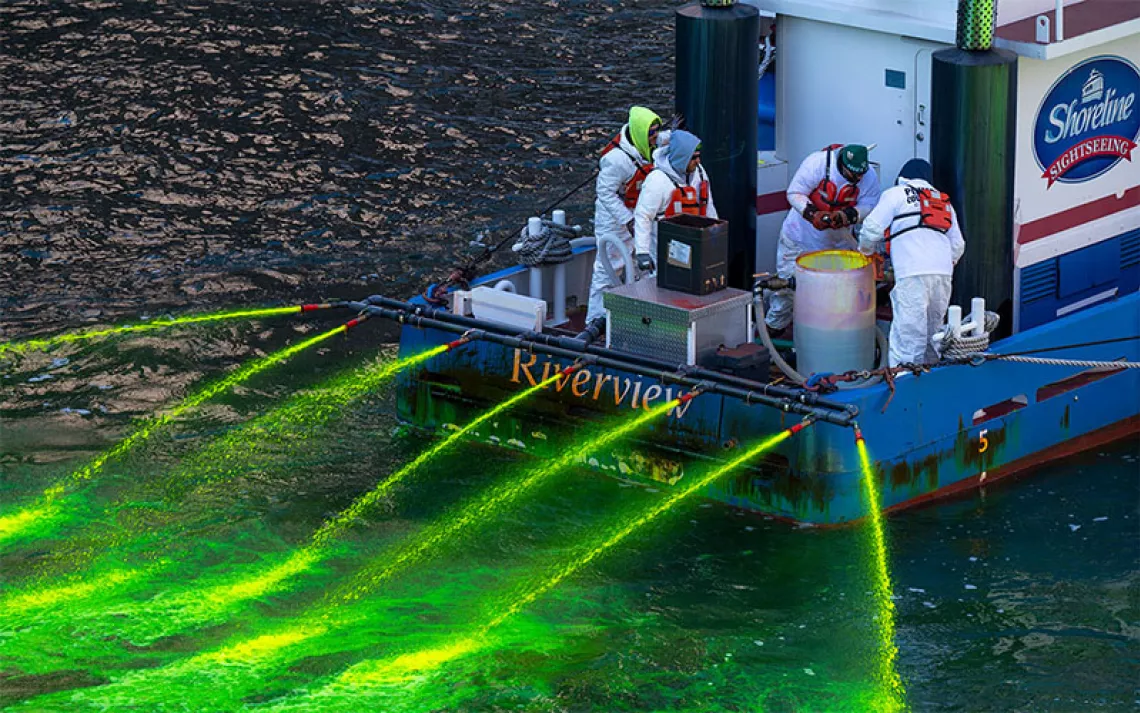Elbows Deep
As activism goes digital, it also becomes more abstract. Ted Haviland and the Ozark Stream Teams stay focused on a place they can touch.
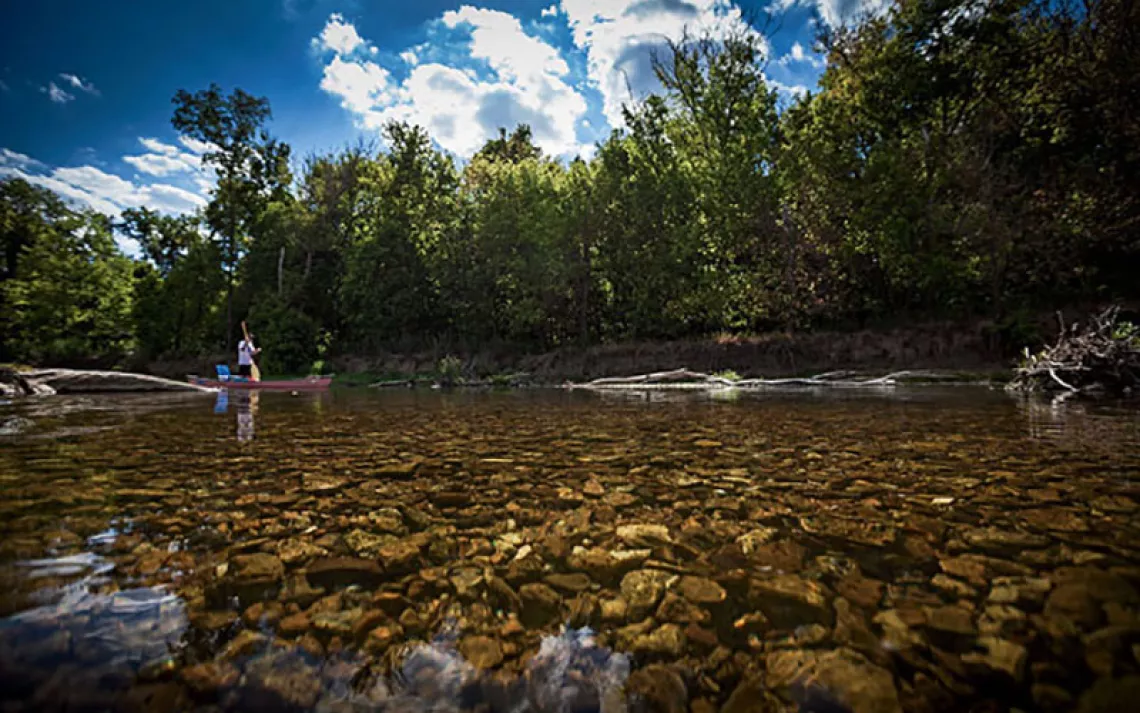
Jacks Fork River, Missouri. | Photos by Nate Luke
DEEP IN A SOUTHERN MISSOURI FOREST, on a geologic thing called the Ozark Dome, lives Ted Haviland, who gets his water from a backyard well that shoots down hundreds of feet, passing through two source pools encased in a massive web of rock. The topography beneath his home is called karst. It has been described as Swiss cheese, blue cheese, a sponge, a strainer—the point being that it is porous, veined, caverned, populated by underground lakes and run through with innumerable underground streams, which pass beneath the Ozarks like a circulatory system. Anything left on the surface long enough (a tire, a paint can, a collapsed septic tank, whatever) can leach down to these veins. And this is a place where backyard sinkholes are frequently used as dumpsters.
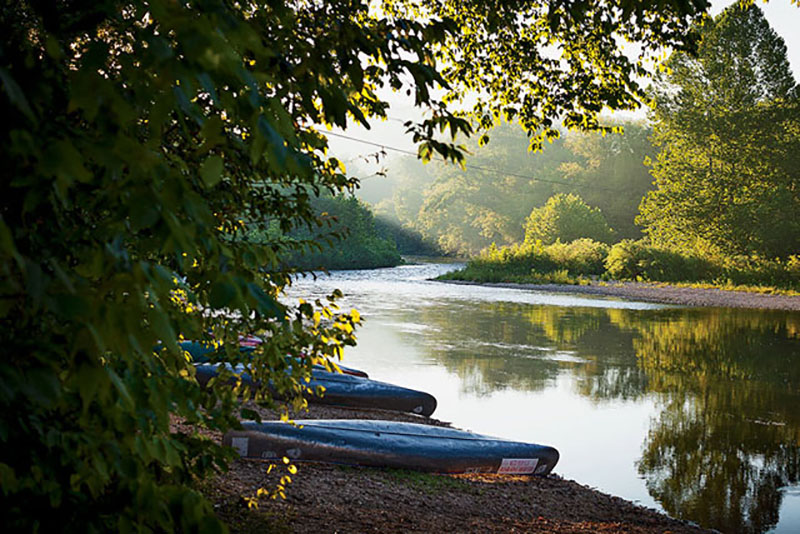
Early morning on the Current River.
These sinkhole dumpsters are just a small aspect of the strong libertarian culture here, where there's the sense that land ownership is absolute. It means that if you own a sinkhole, you can dump whatever you want in it, no matter if it's going to end up in Ted Haviland's well 25 miles away. It means that a person can burn down his termite-infested house and build a new one 10 feet east, can ATV anywhere, can let a horse craft apple necklaces on the river surface.
As an outsider, you might come into the region and, as I did, marvel over some endless green valley, only to have a woman whisper in your ear, "That's a giant sinkhole." A man will offer you a puff of his pipe and say, "That baccy's from 1962." The grocery clerk will shake his head gravely because you lack protection—meaning, you should be armed. You will see Glocks on hips, cowboy-style, and barely pubescent chain-smokers. You will learn that squirrel gravy tastes good; that 'coon is a dark, greasy meat to be eaten with ample sauce; that "possum on the half shell" (i.e., armadillo) is just about the only thing you don't want to eat; that killing a snake is easy because it will literally bite the bullet; and that, on Saturday nights, the counterculture here orbits around Gothabilly bands in dark hollows.
And you will learn that to some people, water is a precious element. Ted Haviland and his wife, Pat, have their own 10 acres of woodland near Mountain View, Missouri, where they can do whatever they want. One of his pastimes is to hunt squirrel with a muzzle-loader. She likes to shoot snakes. But when it comes to the ground and groundwater, they don't mess around. And for the 20-plus years they've worked as water protectors—Ted dislikes the term "environmentalists" because it reminds him of "a dreadlocked woman shouting from a tree"—their sole charge has been the Ozark waterways. Forget the broad strokes of conservationism—the far-flung coal plants and the melting ice caps, the Internet buttons, the donations, the abstractions. The Havilands are mud trudgers, old-school word-of-mouth organizers who maintain a world they can reach out and touch, and the Jacks Fork River flows right through its center.
Which brings us to the Prongs, a little bight near the headwaters of the Jacks Fork where the Havilands monitor quality about four times each year. They are Missouri Stream Team No. 713. They protect this bend.
Among National Park Service rangers, the Ozark National Scenic Riverways is notorious as a near-futile assignment. To patrol 134 river miles, four major campgrounds, hundreds of miles of unauthorized ATV trails, and, between May and October, 9,000 debaucherous equestrians, there are a mere 16 law-enforcing park rangers.
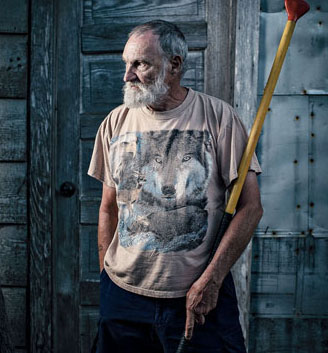
Outside his well house, Ted Haviland holds an oar he built from two broken paddles; its length allows him to canoe standing up.
The tension between the rangers and the region's residents goes back to the 1960s, when a large portion of the park's 80,000 acres were acquired via eminent domain. Local activists like Ted and Pat Haviland bridge that divide while aiding the understaffed Park Service. "Thin as we're stretched, the Stream Teams help us out tremendously," Bill Black, superintendent of the Ozark National Scenic Riverways, said when asked about the Stream Teams' 2012 Jacks Fork River cleanup, during which 150 volunteers collected more than a ton of trash. "They set an example to keep the park clean, and folks respect that."Â
Now, Ted is doing his bug dance in the August heat. It's a dance he's done hundreds of times. In the middle of the river, with a bend of the waist and a plunge of the hands, he moves around wildly, trying to stir up whatever critters are hiding in the rock bed so he can capture and count them. It looks like a dance you might do around a fire if you were demonically possessed. I stand downriver, catching his splash and seining the mud cloud.
After a few minutes of this, I follow Ted out of the water. He walks with his pasty arms stuck out for balance, his head tucked. At 71, he is spidery, agile, with an up-jutting chin, a sloped hat, and clear blue beamers set back in his head. His face seems to converge at a vanishing point between the eyes. He speaks in a chewy whisper. You feel you're hearing secrets.
"Now just put it right on that table there," he says.
Obeying, I position the seine—a screen amid two plastic pipes that rolls up like a map. Once set on a portable table, it's a scrim of pebbly mud, with water flowing over and through in deltas. Or so it seems to my eyes, which are still in flat-screen mode, unready to discern subtle changes in texture.
TED LEANS OVER THE STAND and sticks his face in mine. "Look at 'em all." A smirk spreads, a smirk that says, You're just like the schoolkids. Because I don't see what he sees.
But then my eyes adjust to the logic of the mud, and a constellation of larvae and crawdads resolves into sight.
"It's crawlin' with buggers!" he says.
Craning a pair of tweezers, Ted brings into his palm a pinky-size arthropod. I would say centipede, but it's too robust to be a centipede. Armored, segmented, fitted with dark brawny mandibles, it looks like the war machine of the river bottom. He cups it near his chest, his shoulders drawn into a protective canopy, and says, "Dobsonfly."
"That's a fly?" I ask.
"He's a hellgrammite now. This guy'll become a dobsonfly," Ted says.
"Those are some pincers."
"Ooooo yeah. Uses those to hunt. You put him in the ice tray, and he crawls into the other parts and eats the smaller bugs, like a lion." Without looking up from the seine, he says, "Hon, we got a hellgrammite."
"OK. Hellgrammite." Pat, seated in a beach chair on the rocks, marks it on her sheet with a flourish of the wrist.
Because the buggers rely on consistent water quality, taking inventory of them is a more accurate way to gauge a river's average health over time than, say, measuring its nitrate content, which can change momentarily.
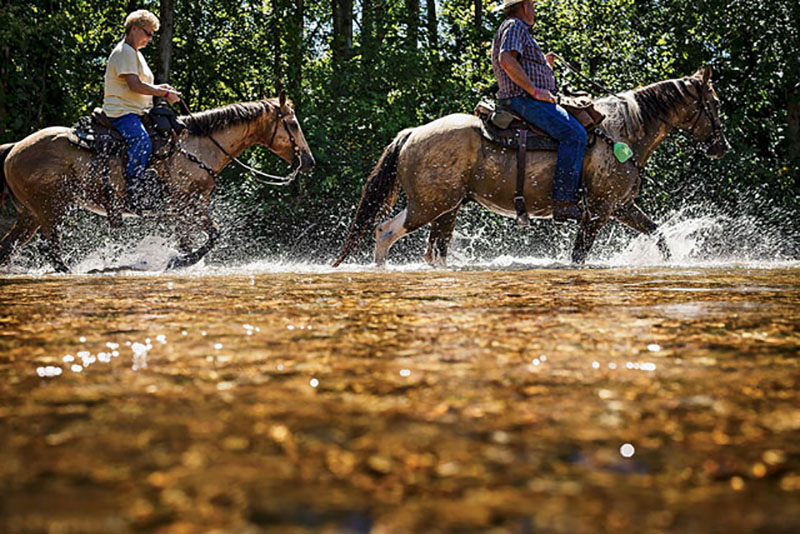
On summer weekends, incessant horse crossings can disturb riverbeds, causing silt to cloud the water.
I pinch up a translucent tube. It is gel-filled and moves like a caterpillar.
"You know what I tell students about that one?" Ted chewy-whispers. "I tell them it's bait. Then they're interested."
"What is it?"
"Let me see here. I think it's a water snipe."
"Water snipe," Pat says.
"Not yet, hon. We gotta look it up. Now let me see here." Ted runs a finger down a paper titled "Dichotomous Key to Stream Macroinvertebrates." He says, "Fleshy, fingerlike extensions, head not apparent, up to four inches. Now that's a crane fly." He raises his voice. "You hear that, hon?"
"Crane fly. Got it."
We tweeze more buggers into an ice tray, calling out our discoveries to Pat. As we go on, I realize that more and more things I thought were water beads are really water fauna in various phases of their wriggling, infinitesimal lives: riffle beetle, crawdad, dragonfly, midge, and so on.
These upper waters are healthy and clean. In fact, as we plug our bug count into a formula from the Missouri Department of Natural Resources, we learn that this part of the Jacks Fork, though low and overwarm, is in certifiably excellent condition.
The sun crawls out from behind a tree, and the Havilands spend another two hours doing the work that the Department of Natural Resources has trained them to do. Ted does the bug dance twice more, a few yards up- and downriver of the first spot. Seine, count, return, excellent. Seine, count, return, excellent.
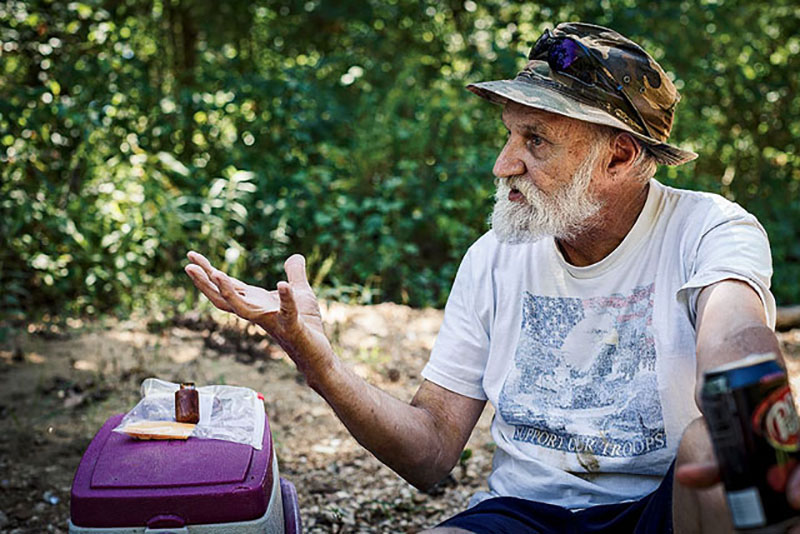
Whirling waters on the Jacks Fork.
As we pack up, a high-pitched, cigarette-worn cry ripples over the river. "Poleigh! Poleigh! Poleigh Ester!" Pat is calling for their dog, a Boston terrier clad in a personal flotation device, which has trotted upriver to cool off. I feel a tinge of sympathy for it. We seem to be in a pocket of trapped heat, and the warm water offers no refreshment. Ted tells me it's not normal for this water to be so warm, so low. I look back at the river. It wends between towers of foliage, all prematurely brown. The whole scene gives off an infernal feel, a hint that we're looking through a window to some future when the forest water will be too hot to cool us down or nourish the trees on its banks.
Ted does a trash sweep. He gives me a long, tight hug, and then we leave the Prongs behind.
Another torrid day in the Ozarks. It is the annual Scenic River Stream Team Association picnic. Team No. 713 is here in full, along with a dozen other teams that work in the Ozark National Scenic Riverways. Rows of volunteers shelter under a pavilion, gossiping about the horrible sun, about a small wash of rain that came down last night. The heat has been unrelenting, and rumors of its effects swirl through the air. Cattle are said to be swarming to felled trees and ripping off the leaves just to chew something damp. One guy says that he tried to hose a squirrel away from his garden but that it just stood in the spray, lapping water off its belly and paws. The air is as crisp and dry as an empty skillet over fire. You can almost sense the river evaporating as it trickles on through.
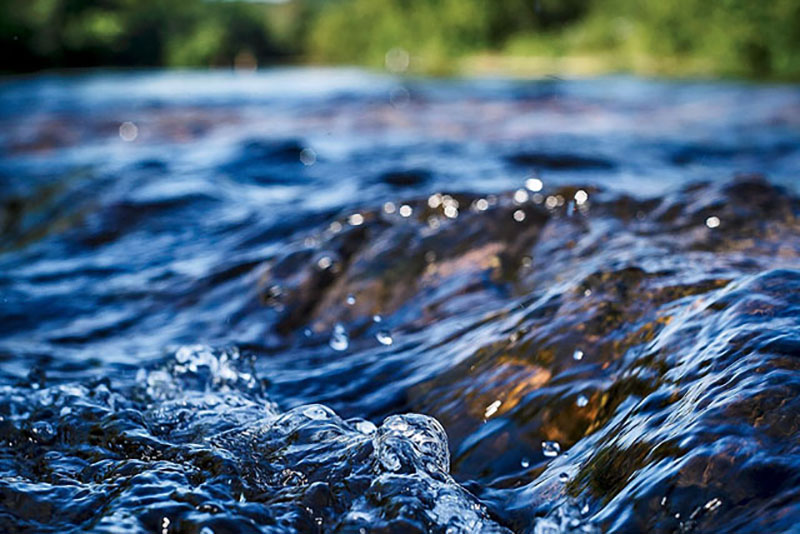
Ted Haviland explains pipe-packing over lunch.
Ted Haviland sits off to the side, legs crossed, back arched, chin curled to a knee. He puffs on his pipe. Here, he holds the status of a village elder. To the kids, he is a quirky grandpa. To the adults, he's a respected sage on the subjects of river quality and pipe carving. For 20 years he's watched over this river. He wants to tell me who everyone is.
He points first to Angel and Tom Kruzen, the rare Stream Teamers who write grants and deal with politicians. As he continues down the line of sweating bodies, though, he realizes that the web of relations is too tangled to explain, and so he pantomimes playing banjo while tooting the Deliverance riff.
AT THE END OF THE TABLE is the future of Ozark groundwater. About a half-dozen kids talk to one another. While most Ozarkians their age are out riding ATVs or horses through the river, stirring up sediment and flattening grass, the Stream Team progeny prepare to build cardboard canoes. A few teenagers—too old for the competition but probably too young to smoke—slouch and take drags from Parliaments.
Ted announces that it's time for the youngest kids to build their canoes. He suggests that I join the youthful Boyer family. The trio sit in a little triangle among collapsed cardboard boxes and rolls of duct tape. My plate buckling under a puddle of baked beans, I ask if they could use another hand. "Yeah, you can help us," Matt Boyer says, introducing himself. "She's with me," he adds, gesturing to Trista, then down to a girl in a Nickelodeon swimsuit. "And that's Phoebe."
Matt, 29, has a golden ponytail and two nipple rings and wears denim shorts. Trista, 28, has huge green eyes and wears a sundress. He repairs vehicle transmissions, and she works at a local water department. We are to build a canoe out of box fragments that five-year-old Phoebe will use to race the other kids. After several years of these picnics, they've made this into an art form. You double-plate the hull, use the entire roll of duct tape as a sealant, and angle the bow. But it's also a young art form, which leaves room for ingenuity. As we pass and rip the tape, the conversation moves from our guesses about leaky spots to Matt's sword collection.
"What do you do with the swords?" I ask.
"They're mostly a hobby."
"Or for a zombie apocalypse," Trista says, laughing. "Self-defense. Tell him about the time with the neighbors."
"Our neighbors were always fighting and screaming. He was always beating on her. This one time she was really shrieking, so I went out with the Decapitator in my pajamas."
"What's the Decapitator?"
"It's basically a really big sword."
"But it's dull?"
"It's sharp as hell."
"Then what happened?" I ask.
"I told him he better stop beating on her."
"But have you ever actually used swords?" I search for a plausible example. "Like for hunting?"
"Sometimes I'll wear them around town."
Ted walks figure eights through the field. As MC of the canoe-building event, he struts and prowls, a drill sergeant with watch in hand. "Fifteen minutes!" he calls out, puffing baccy smoke up over his pebbly blue eyes.
The Boyers don't actually believe in the undead kind of zombie. They have a vague fear of people driven insane by viruses and zillion-strong fleets of nanobots hijacking human bodies. Their true worries are nuclear war, a stock market catastrophe, massive drought, and, at the center of everything, Phoebe's future.
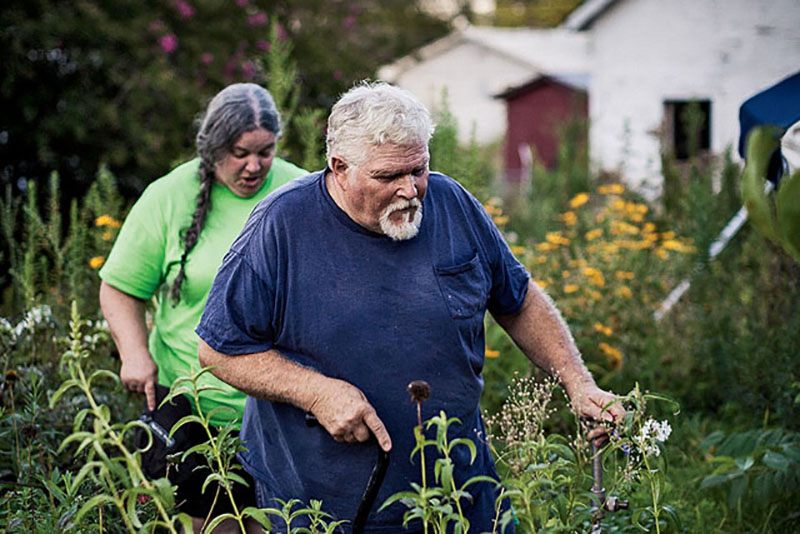
In the early 1980s, Tom and Angel Kruzen moved to the Ozarks from Iowa, where the groundwater was mixed with pesticides. They are Sierra Club Water Sentinels volunteers and belong to Stream Team 274.
Done building, we head for the river. The adults dot themselves through the shallows. Some sit and splash the hot water over their chests. The Prongs are about 25 miles upriver from here, and the difference in water quality is noticeable. Last week, a farm spilled waste a few miles upstream, and now algae flows everywhere, tailing off underwater logs like bright green hair in the wind. The algae gets worse about seven miles down, where horses from across Missouri converge at a camp in the town of Eminence and drop massive amounts of manure in the water, before everything clears up near the town of Two Rivers as the Jacks Fork merges with the larger Current River.
Captain Phoebe floats to the finish in second place, her hair and shoulders visible above the cardboard gunwales. She smiles and splashes, barely aware of having won or lost. She probably won't remember this afternoon, but she'll remember this river, these picnics, these canoe races, and all the people in a fuzzy throng, memories seeping into her soul like water through the Ozark ground.
 The Magazine of The Sierra Club
The Magazine of The Sierra Club



